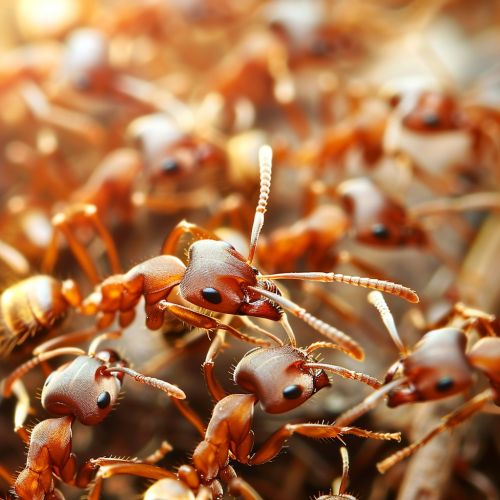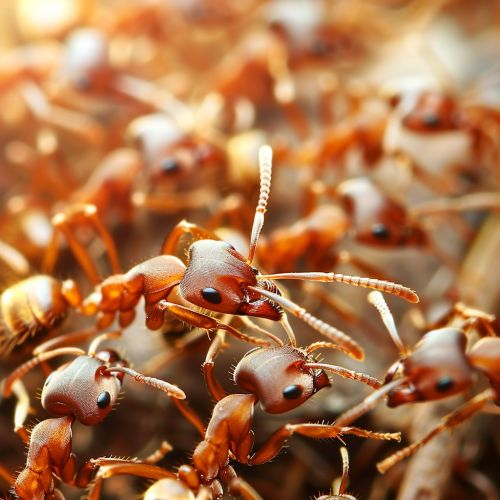Chemical communication in insects
Introduction
Chemical communication in insects is a sophisticated and highly evolved form of interaction that plays a crucial role in their survival, reproduction, and social organization. This form of communication primarily involves the production, release, and detection of chemical substances known as pheromones. These chemical signals can convey a wide range of information, including mating readiness, territory boundaries, alarm signals, and the presence of food sources. This article delves into the various aspects of chemical communication in insects, exploring the types of pheromones, their mechanisms of action, and their ecological and evolutionary significance.
Types of Pheromones
Insects utilize a diverse array of pheromones, each serving specific functions. The primary types of pheromones include:
Sex Pheromones
Sex pheromones are crucial for mating and reproduction. They are typically produced by females to attract males, although in some species, males also produce pheromones to attract females. These pheromones can be highly specific, ensuring that individuals attract mates of the same species. For example, the silkworm moth (Bombyx mori) releases a sex pheromone called bombykol, which is detected by males from great distances.
Aggregation Pheromones
Aggregation pheromones cause individuals to congregate in a particular area. These pheromones are often used to attract conspecifics to a food source or a suitable habitat. For instance, bark beetles release aggregation pheromones to attract other beetles to a tree, facilitating mass attack and overcoming the tree's defenses.
Alarm Pheromones
Alarm pheromones are released in response to a threat, triggering an escape or defensive response in other members of the species. Ants, for example, release alarm pheromones when they are disturbed, causing nearby ants to become aggressive and mobilize for defense.
Trail Pheromones
Trail pheromones are used by social insects such as ants and termites to mark paths to food sources. These pheromones are laid down as the insect moves and are followed by other members of the colony. The strength of the pheromone trail can indicate the quality and quantity of the food source.
Epideictic Pheromones
Epideictic pheromones, also known as spacing pheromones, are used to regulate the distribution of individuals in a habitat. These pheromones help reduce competition by signaling to others that an area is already occupied. For example, female fruit flies release epideictic pheromones to deter other females from laying eggs in the same fruit.


Mechanisms of Pheromone Detection
The detection of pheromones in insects involves highly specialized sensory organs and neural pathways. The primary organs responsible for pheromone detection are the antennae, which are equipped with numerous sensilla—tiny hair-like structures containing olfactory receptor neurons.
Sensilla and Olfactory Receptors
Sensilla are the primary sensory structures involved in pheromone detection. They house olfactory receptor neurons that bind to specific pheromone molecules. The binding of a pheromone to its receptor triggers a cascade of neural signals that are processed in the insect's brain, leading to an appropriate behavioral response.
Neural Processing
Once pheromone molecules bind to olfactory receptors, the resulting neural signals are transmitted to the antennal lobe, the primary olfactory processing center in the insect brain. Here, the signals are integrated and relayed to higher brain centers, such as the mushroom bodies and the lateral horn, which are involved in learning, memory, and decision-making.
Ecological and Evolutionary Significance
Chemical communication plays a vital role in the ecology and evolution of insects. It influences various aspects of their behavior, including mating, foraging, and social organization.
Mating and Reproduction
Sex pheromones are essential for successful mating and reproduction in many insect species. They ensure that individuals can locate and recognize potential mates, thereby facilitating gene flow and maintaining species integrity. The evolution of species-specific pheromones helps prevent hybridization and promotes reproductive isolation.
Foraging and Resource Location
Aggregation and trail pheromones are critical for foraging efficiency. By signaling the presence of food sources and guiding conspecifics to these locations, these pheromones enhance the survival and fitness of individuals and their colonies. This cooperative behavior is particularly evident in social insects like ants, bees, and termites.
Social Organization
In social insects, chemical communication is fundamental to colony organization and function. Pheromones regulate various aspects of colony life, including caste differentiation, brood care, and defense. For example, queen pheromones inhibit the reproductive development of worker bees, maintaining the colony's hierarchical structure.
Defense and Alarm
Alarm pheromones play a crucial role in colony defense. They enable rapid communication of threats, allowing for coordinated defensive actions. This is particularly important in eusocial insects, where the survival of the colony depends on the protection of the queen and brood.
Applications of Pheromone Research
The study of insect pheromones has numerous practical applications in agriculture, pest management, and conservation.
Pest Control
Pheromone-based pest control strategies, such as mating disruption and mass trapping, are widely used in agriculture. By releasing synthetic sex pheromones, these methods interfere with the mating behavior of pest species, reducing their populations without the need for chemical insecticides.
Pollination and Conservation
Understanding the chemical communication of pollinators can aid in their conservation and management. For example, identifying the pheromones that attract bees to flowers can help in designing more effective pollination strategies for crops.
Invasive Species Management
Pheromone traps are used to monitor and control invasive insect species. By attracting and capturing individuals, these traps help prevent the establishment and spread of invasive populations.
Future Directions in Pheromone Research
Advancements in molecular biology, genetics, and neurobiology are opening new avenues for pheromone research. Future studies may focus on:
Genetic Basis of Pheromone Production and Detection
Understanding the genetic mechanisms underlying pheromone production and detection can provide insights into the evolution of chemical communication. Identifying the genes involved in these processes may also lead to the development of novel pest control strategies.
Neurobiological Mechanisms
Investigating the neural circuits and pathways involved in pheromone detection and processing can enhance our understanding of insect behavior. This knowledge can be applied to develop more targeted and efficient pest management techniques.
Synthetic Pheromones
The synthesis of pheromones and their analogs holds promise for various applications, including pest control and pollination. Developing cost-effective and environmentally friendly methods for pheromone synthesis is a key area of research.
Conclusion
Chemical communication in insects is a complex and highly specialized form of interaction that plays a crucial role in their survival and ecological success. The diverse array of pheromones and their sophisticated detection mechanisms highlight the evolutionary significance of chemical communication. Ongoing research in this field continues to uncover new insights and applications, contributing to our understanding of insect behavior and offering potential solutions for pest management and conservation.
